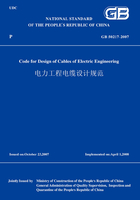
2 Terms and Definitions
2.0.1 Fire Resistance
The ability of a specimen to resist burning in fire for a certain period of time under specified test conditions while maintaining its normal operation.
2.0.2 Fire Resistant Cable
Cables characterized by fire resistance.
2.0.3 Flame Retardancy
The characteristic of a test specimen that,after being burned under the specified test conditions and following the removal of the test fire source,the flame spread is confined within the specified scope and the resulting residual flame or residual matters can extinguish by itself within a limited period of time.
2.0.4 Flame Retardant Cable
Cable characterized by flame retardancy.
2.0.5 Dry-type Cross-linked
A cross-linking process whereby the amount of water used in the production of cross-linked polyethylene insulation is significantly reduced.
2.0.6 Water Tree
A brief term to describe the phenomenon of dendritic tiny cracks occurring in the insulation layer of XLPE cables during operation.
2.0.7 Metallic-plastic Composite Water Barrier
A water barrier consisting of a composite tape surrounding cables longitudinally which is composed of thin metallic layer such as aluminum or lead foil sandwiched in a plastics layer.
2.0.8 Thermal Resistance
A physical quantity defined by the thermal ohm law for the one-dimensional heat dispersion process using the thermal network analytic method to calculate the current-carrying capacity of cables.
2.0.9 Auxiliary Ground Wire
Conductor laid in parallel with HV single-core cable line and grounded at both ends to establish a circuit for induced current.
2.0.10 Direct Burying
A cable laying method where cables are laid down on cushions at the bottom of the underground trenches and covered with a overburden layer,followed by placing protection slabs and then leveling the ground.
2.0.11 Channel
A covered trough structure without brackets intended to contain small quantity of cables.
2.0.12 Manhole
Acovered pit-type cable structure that can be accessible for installation of accessories such as cable joints or for pulling cables.
2.0.13 Cable Buildings
Structures including cable troughs,channels,ducts,tunnels,mezzanines,shafts and manholes exclusively intended for laying cables or installing accessories.
2.0.14 Slip Fixing
A fixingmethod that allows cables to experience axial angle change or slight transverse displacement at the attachment point attributable to thermal expansion and contraction of cables.
2.0.15 Rigid Fixing
A clamping fixing method by which cables will not displace as a result of thermal expansion and contraction.
2.0.16 Snaking of Cable
A cable laying method by which cables are rendered to be in the form of a snake,which contributes to decreased axial cable thermal stress and increased free expansion and contraction consistent with the requirements of quantitative parameters.